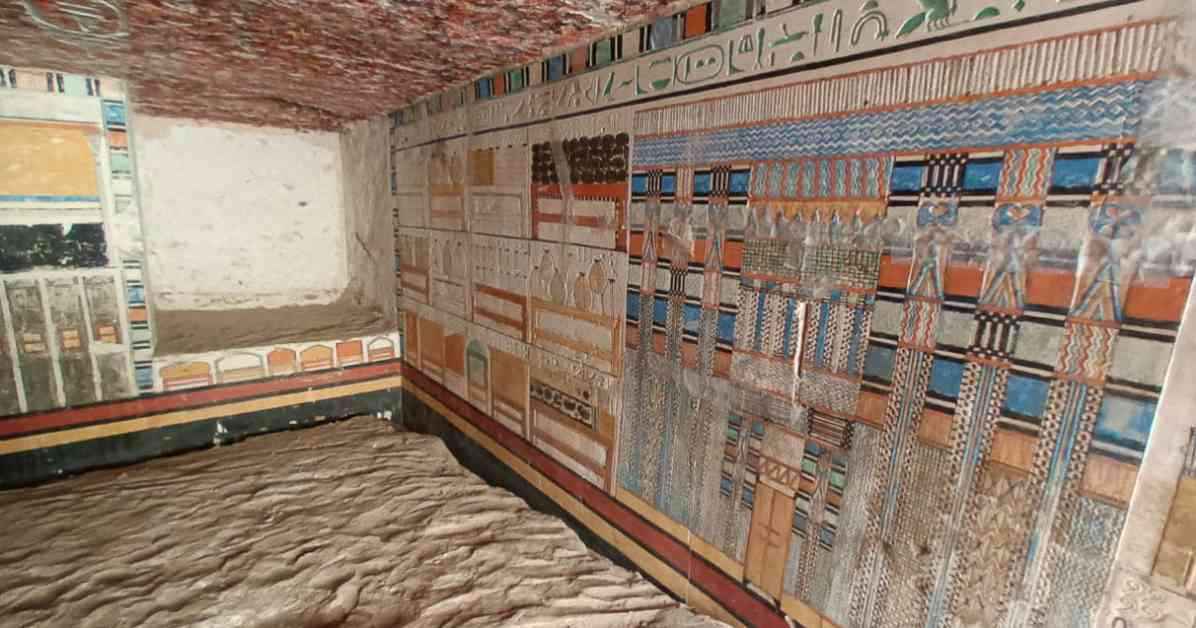Saqqara, a burial ground filled with the remains of Egyptian royalty and noblemen, has recently captured the attention of archeologists from the Swiss-French Mission Archéologique Franco-Suisse de Saqqâra (MAFS). In 2023, this team stumbled upon a series of smaller burials near an ancient Egyptian tomb, uncovering a particularly intriguing discovery—a kiln tomb belonging to a royal physician named Tetinebefou.
A Fascinating Tomb Unearthed
The tomb itself, constructed from mud bricks with a vaulted ceiling, is a rare find in Saqqara. Unlike the typical simple and often looted tombs found in the area, this burial site still retained vibrant wall paintings, providing a glimpse into the life and work of Tetinebefou. Despite the absence of human remains or physical artifacts, the colorful abstract images, geometric patterns, and hieroglyphic inscriptions adorning the walls offered valuable insight into the physician’s roles within ancient Egyptian society.
Egyptologist Philippe Collombert, the lead researcher of the MAFS team, shed light on Tetinebefou’s prestigious titles, which included “director of medicinal plants” and “chief dentist.” One of his titles, “conjurer of the goddess Serqet,” indicated his specialization in treating poisonous bites—a vital role in a land teeming with venomous creatures. Collombert emphasized the rarity of such titles, suggesting that Tetinebefou held the highest positions in his field, likely serving as the principal physician at the royal court and attending to the pharaoh himself.
A Royal Connection
While the specific pharaoh under whom Tetinebefou served remains a mystery, Collombert speculated that he may have worked alongside Pepi II, a prominent ruler of Egypt’s Old Kingdom and the Sixth Dynasty. Pepi II’s reign, lasting an unprecedented 60 to 94 years, began when he was just a child and witnessed the gradual weakening of the government due to internal and external challenges. Following his death, Pepi II was interred in a pyramid, marking the end of full pyramid complexes in ancient Egypt.
The discovery of Tetinebefou’s tomb not only sheds light on the intricate roles of physicians in ancient Egyptian society but also underscores the meticulous care taken in preserving the memory of these esteemed figures. As archeologists continue to uncover the mysteries buried beneath the sands of Saqqara, each find offers a tantalizing glimpse into a bygone era, where art, science, and spirituality intertwined to create a rich tapestry of history.
Sources:
– Visite surprise d’un médecin
– 4,100-year-old tomb of doctor who treated pharaohs discovered at Saqqara
In a world where the past often feels distant and inaccessible, the unearthing of Tetinebefou’s tomb serves as a poignant reminder of the enduring legacy of ancient civilizations. As we marvel at the vibrant paintings adorning the walls of his burial site, we are invited to step back in time and witness the intricate tapestry of life in ancient Egypt—a world where art, medicine, and spirituality converged to shape the course of history. The story of Tetinebefou, the royal physician of Saqqara, continues to captivate our imaginations, offering a glimpse into a world where healing hands held sway over life and death, and where the legacy of a single individual could echo through the annals of time.












